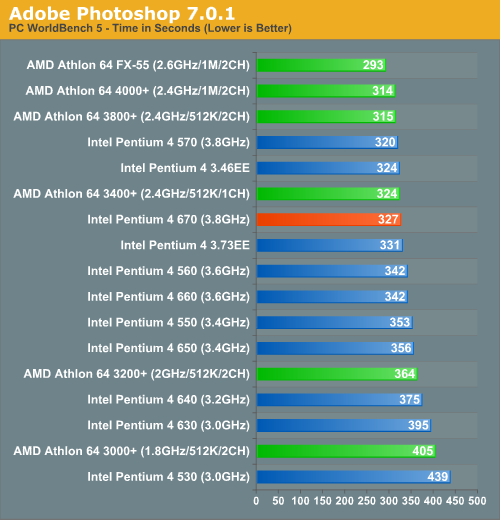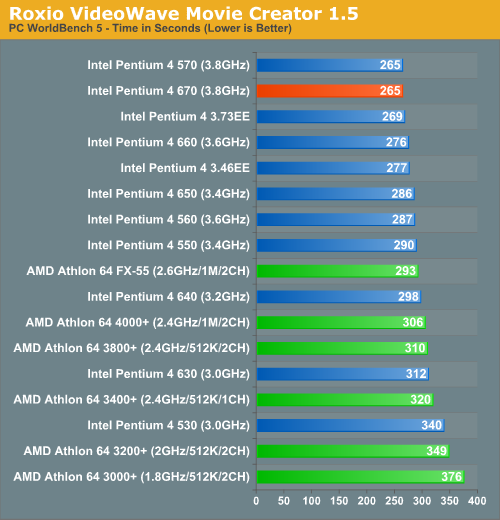Intel's Pentium 4 670: Just Another Speed Bump
by Derek Wilson on May 26, 2005 9:00 AM EST- Posted in
- CPUs
Video Creation/Photo Editing
Adobe Photoshop 7.0.1

Adobe Premier 6.5

Roxio VideoWave Movie Creator 1.5
While Premier is a wonderful professional application, consumers will prefer something a little easier to use. Enter: Roxio's VideoWave Movie Creator, a fairly full-featured, yet consumer level video editing package.










33 Comments
View All Comments
JustAnAverageGuy - Thursday, May 26, 2005 - link
"And I suppose if AMD released a venice core clocked @ 2.6 Ghz, you all would not be calling it "just a speed bump". Rather, it would be considered a huge deal, and you all WOULD care."2.4 --> 2.6 != 3.6 --> 3.8 (% speed increase)
Also consider the fact that 200 "A64 Mhz" aren't equal to 200 "P4 MHz"
AkumaX - Thursday, May 26, 2005 - link
#11,They're trying to distinguish between S754 and S939 (single channel vs dual channel memory)
is my S754 Newcastle @ 10 x 240 = 2400mhz really that slow? :P
Admiral Ackbar - Thursday, May 26, 2005 - link
Sorry but I have missed something, what does the 1CH versus 2CH mean on the Athlons?mjz - Thursday, May 26, 2005 - link
5 - Posted on May 26, 2005 at 2:42 PM by flatblastard ReplyAnd I suppose if AMD released a venice core clocked @ 2.6 Ghz, you all would not be calling it "just a speed bump". Rather, it would be considered a huge deal, and you all WOULD care.
----
don't forget, a 200 MHz increase with AMD cpus is like a 300+ MHz increase for intel
ViRGE - Thursday, May 26, 2005 - link
#3 is right, there are some major discrepancies between the actual results and what was predicted. Take a look at the WinZip and Nero numbers; for Winzip, the 650->660->670 comes in at 430->411->349 respectively(or a difference of 29->62), and Nero shows 560->550->456(for a difference of 10->94!). Something has to have been changed her, be it a hard drive or drivers; the 670 scores do no correlate with the other 6xx scores at all.mlittl3 - Thursday, May 26, 2005 - link
#5,This article would be worded totally different if the 670 performed consistently better than the 570 from benchmark to benchmark. Instead it wins some and loses some.
As #4 says, even the 3.43 gallatin EE beats the 3.73 prescott EE in a lot of the benchmarks.
Intel is unreliable when it comes to new processors until the Pentium M is revamped in the form of Yonah and of course as #6 stated Conroe (don't forget Cedar Mill).
AMD was bashed left and right when they went from Palamino to Thoroughbred A to Thoroughbred B to Barton. There were very little performance improvements between these chips and they kept getting hotter and hotter. Review sites were constantly saying that the Athlon XP had gone as far as it can go and ran out of steam around the Athlon XP 2500+.
Therefore, AMD came out with the Athlon 64 and fixed all the problems. Each release of a new chip usually has brought speed improvements and decreased power usage.
Now its Intel's turn. The Pentium 4 architecture has run out of steam. Each new processor brings nothing new to the table and in some cases hurts performance. The Pentium 4 was at the peak with the Northwood core, therefore, logically, reviews sites and comment boards are bashing Intel.
Once Intel releases the next gen processors and AMD's Athlon 64 runs out of steam, the review sites and comment boards will change directions once again as always.
Please read this article at xbitlabs for further info on the history of the Pentium 4 and why Intel is no longer going to support it soon.
http://www.xbitlabs.com/articles/cpu/display/netbu...
yacoub - Thursday, May 26, 2005 - link
"In order to continue getting the same performance boost form part to part"form/from
=)
BitByBit - Thursday, May 26, 2005 - link
The 6xx line is to the Athlon 64 as Barton was to the P4C - just a fill-in to avoid embarrassing benchmark defeats until Intel's replacement appears; Conroe.flatblastard - Thursday, May 26, 2005 - link
And I suppose if AMD released a venice core clocked @ 2.6 Ghz, you all would not be calling it "just a speed bump". Rather, it would be considered a huge deal, and you all WOULD care.plewis00 - Thursday, May 26, 2005 - link
It does perform well in somethings but the increased latency is bad - the last benchmark, SPECviewperf 8 - Unigraphics V17, where the 5xx series pretty much consistently beat the 6xx, that is awful when it costs so much more, if you pay more for something you'd expect it to perform better. Similar thing with the 3.4XE (Gallatin-based) and 3.73XE (Prescott-based) in the past. Like many others I'm jumping ship on Intel now unless I can easily get a hold of a Pentium M SFF with SATA support (I'd rather not get the 915 cos of PCIe and DDR2), let's face it, Pentium M is pretty much Intel's only strong performer these days...